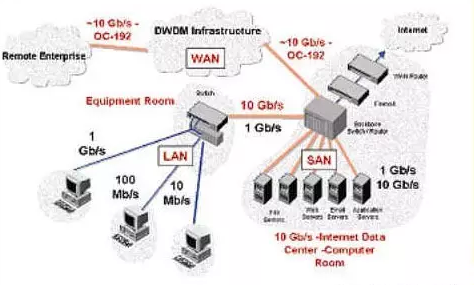- Related articles
- What media type is 1000BASE-T?
- Optical Transceivers for Cisco WS-C3750V2-24FS-S Switch
- What is 1000BASE T Transceiver?
- All Cisco QSFP-40G-LR4-S’s Information (Overview, Features, Datasheet PDF, Price, Specific
- What Is GYDXTW Fiber Optic Cable?
- All Cisco CWDM-GBIC-1510's information (List price, Specs, Datasheet PDF, Compatibility ma
- Optical Transceivers for Cisco SG200-50FP-EU Switch
- Optical Transceivers for Cisco SG550XG-24F-K9-UK Switch
- Optical Transceivers for Cisco N9K-C9396PX= Switch
- Optical Transceivers for Cisco WS-C3560V224PSS-RF Switch

Nowadays, most of the network transmission rate we are using is 10Mbps, then why now we should plan 10Gbps transmission rate of the local area network (LAN) environment? The reasons have two sides, one is the theoretical reason, and the other is the practical reason.
Due to the rapid expansion of Internet access requirements for web-based applications and integrated multimedia applications (audio/data/video), the demand for broadband networks has been greatly facilitated. The rapid development of microelectronics and fiber-optic networking technology are continually improving the bandwidth capacity of the network. The requirements of people on the network speed are increasing, from 10Mbps to 100Mbps to 1000Mbps, and this requirement will soon allow us to enter 10000Mbps or 10Gbps network.
In theory, we live in a stressful, fast-paced era, so we tend to overlook productivity planning. As a good business manager, we must maintain the balance of tactics and strategic planning, in which tactics affect short-term benefits, while the strategy affects the efficiency of enterprises, competitiveness, and long-term viability. Simply put, "ahead of schedule!" Will be able to anticipate future key technologies and be actively prepared to "plan ahead" and be able to take advantage of them quickly and adequately when these key technologies become possible.
In practice, early planning for the network wiring structure has a very important role. The performance and capacity of network active components can usually be accomplished through relatively simple software and hardware upgrades. Unlike this, the infrastructure of the cabling has a range of performance and cannot be improved without replacing the cables and connectors. This upgrade is interrupted and costly, including the direct costs associated with reassembling the cables, as well as the indirect costs of cabling causing network performance degradation and reduced productivity.
So, while some people think that it is too early to consider a 10Gbps LAN in the currently installed 10 / 100BASE-T network, knowledgeable network administrators have recognized that gigahertz clock frequency workstations, gigahertz Ethernet and " stream" multimedia applications and other emerging technologies may soon become a reality in their networks. In order to make the network with sufficient capacity and full performance, so that in the future when necessary, smooth and rapid implantation of these new technologies, today's forward-looking managers will prefer to consider 10Gbps LAN technology.
Conclusion
Because there are a variety of mediums and a variety of technologies to choose from, so business and service provider network managers can use in a variety of ways in the network upgrade. For enterprise LAN, the use of 10Gbps Ethernet network allow managers to make their Ethernet from 10Mbps, 100Mbps or 1000Mbps upgrading to 10000Mbps, and by improving network performance, making full use of Ethernet investment. The most rule of thumb, we must bear in mind that the speed of the network should be at least 10 times faster than the speed of the terminal. For service providers, 10Gbps Ethernet will provide better performance and cost-effective links in metro and wide-area applications and is easy to manage with familiar Ethernet tools. 10Gbps Ethernet can meet the wide-area backbone of the fastest technology OC-192 speed requirements, the rate of about 9.6Gbps.






































































